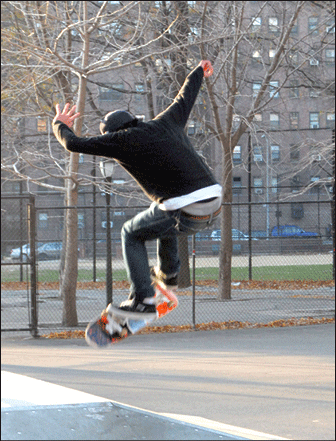By Julie Shapiro
Rather than using a $2 million grant to build one baseball field Downtown, athletic programmers now hope to spread the money over two parks.
The suggestion emerged during an informal meeting last week between several youth leaders in Community Boards 1 and 3. Last month, the Parks Department announced it would be installing a new artificial-turf ballfield in Corlears Hook Park, using a Lower Manhattan Development Corporation grant to Downtown Little League. But some programmers now want to refurbish an existing diamond in Coleman Square Playground as well.
“We’re very excited about the possibility,” said John De Matteo, athletic director at the Manhattan Academy of Technology, one block from Coleman Square Playground. “All the parties would win.”
The Coleman ballfield’s sand-and-grass surface at Monroe and Market Sts. is full of roots and branches that make play dangerous, De Matteo said after the meeting. There are no lights, which means leagues cannot play after dark. If Parks adds lights and artificial turf, children’s and adults’ leagues will have a safer, more versatile playing space, he said.
The ballfield advocates hope to meet with Manhattan Borough Parks Commissioner Bill Castro after Christmas. Parks representative Cristina DeLuca had not heard of the idea and said Parks is going ahead with plans to build a lighted turf field in Corlears Hook Park.
The informal ballfield meeting came a week after C.B. 3 reacted angrily to news that the Parks Department had sited the ballfield in Corlears Hook Park, over an existing asphalt lot at Jackson St. and F.D.R. Dr., without consulting the community. After several misunderstandings, the Downtown youth sports programmers are now working together, said Mark Costello, president of Downtown Little League.
“When you get the actual programmers together, there isn’t a problem,” said Costello, who was at the meeting. “We’re all about the same stuff.”
Costello pointed to figures on the Parks Department Web site to suggest that $2 million is enough to provide improvements for both fields. In 2005, Parks spent $1.055 million to turf a field at Baruch Playground that is bigger than Coleman and Corlears put together, Costello said. In 2000, Parks lighted a large ballfield in East River Park for $460,000.
Whether Parks goes for the split-funding plan or not, “we’re going to be incredibly grateful and everyone’s going to benefit,” Costello said.
The artificial turf would enable year-round play on Coleman, allowing teams to practice flag football and soccer during the fall, De Matteo said.
“With turf, it would become a first-class facility,” he said.
De Matteo’s students agreed that the field is due for a facelift.
“It’s not that good of a field,” said Lucas Zenna, 13, an M.A.T. student who plays in De Matteo’s baseball league. “It’d be much better with turf.” When baseballs hit the overgrown grass of the field, they stop dead, without bouncing or rolling, Zenna said. He added he also wants to see a real pitcher’s mound, rather than the current patch of dirt that often turns into a mud puddle.
Patty Rosa, 12, an M.A.T. student and softball player, also thinks the field needs improvements.
“It’s definitely hard to play,” she said. In the rain, the grass gets slippery and the sand gets muddy. When Rosa and her teammates use artificial-turf fields in other parks, it’s safer and easier to play, she said.
De Matteo is so enthusiastic about the potential improvements that he’s already planning when and how to use the new field. M.A.T. holds the permit for the Coleman ballfield during the day, but shares the space with other neighboring schools, he said. In his vision, M.A.T.’s baseball and softball leagues would play after school, and then adults would take over at night; on weekends, Downtown Little League and other leagues would have the field.
It is premature to decide on who will use the field when, Costello said, but he added that Downtown Little League is predominantly a weekend program.
Ed Garcia, who runs the Sol Lain Association, attended the informal meeting to advocate for an artificial-turf field in Corlears Hook Park, but said he’d be happy to see improvements in Coleman Square as well. Through Sol Lain, Garcia organizes weekend and vacation activities for children on the Lower East Side. The kids in his program have been playing baseball, football and flag football on the asphalt lot in Corlears Hook since 1993 — and Garcia is grateful that no one has gotten seriously hurt on the hard surface.
“We would love to utilize Astroturf,” Garcia said. “The kids would love to jump on that right away.”
The ideal outcome would be two new ballfields, one at Corlears Hook and one at Coleman, he said.
Ann DeFalco, a C.B. 1 member and chairperson of the Southbridge Towers Parent and Youth Association, said after the meeting that she likes the idea of spreading the funding to Coleman Square.
“The idea is to get the most play time out [of the grant] for all the groups that want to use [the fields],” DeFalco said.
Increased programming hours would benefit Downtown’s underserved athletes and would also make it easier for leagues to coordinate sharing the fields, Costello said. He wants Parks to focus on maximizing playing time, not aesthetic improvements.
“It’s all about creating hours,” he said.
Julie@DowntownExpress.com


































